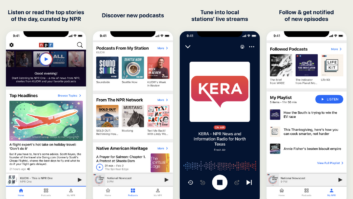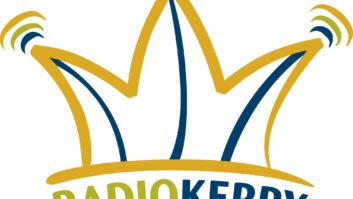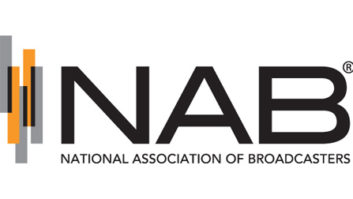
The author is founder and VP digital technologies at All in Media, a supplier of radio station applications and part of Xperi.
There are, more or less, 131 FM radio stations in New York. And only 75 AM stations.
That’s it — that’s the expanse of a content choice that is advertiser-supported and has a built-in limit to how broadly it can get its message out.
Now compare this to the wonderful, sometimes wild, world of apps.
In the iOS world, you can listen to 40,000 radio stations in your car, accessible through your phone or CarPlay. It’s hands-down the sector with the biggest growth — and has been for a long time.
This massive and noisy environment is, today, the cornerstone of a broadcaster’s digital strategy: The infrastructure that a radio station invests in to deploy mobile apps dictates its ability to innovate user experiences, leverage metadata and expand into new integrations such as Amazon Fire TV, Android Auto, Sonos, Bose and Amazon Alexa.
[Read: RadioFX Provides Apps to El Dorado]
Indeed, the right digital infrastructure helps to ensure an expanding and evolving experience across many digital ecosystems.
Expanding the Ecosystem
About a decade ago, the drive for apps was arguably a curious “me too” trend, with little upside.
Since then, as it has morphed into a driver of affordable, scalable innovation, it has, frankly, become a survival imperative for broadcasters to stay ahead of a competitive and constantly evolving digital content landscape. And in the process it has changed the game.
But while good app infrastructure is critical to cost-efficient innovation, it can be a tall mountain to climb.
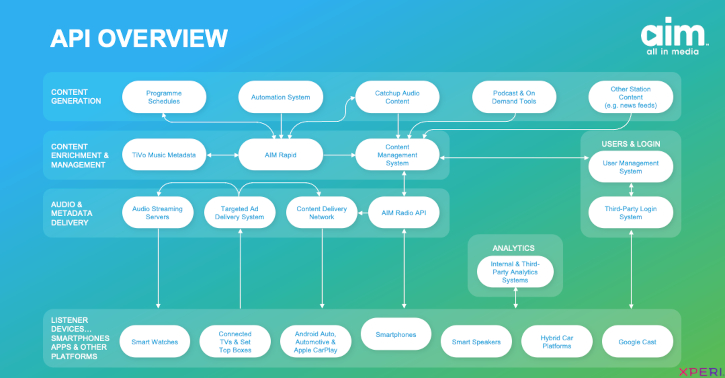
On the surface it looks easy: Apps are user-friendly and simple (that is the whole point of an app); but as seen in Fig. 1, behind the curtain is a complex set of systems and moving parts that must be integrated into a single API in order to open up that innovation efficiency for broadcasters.
A great example of how good app infrastructure opens up new opportunities is Commercial Radio Australia’s app, which brings together different radio stations into a single aggregator app, owned and operated by the radio industry.
At AIM, we worked for years with Australia’s big commercial and public service broadcasters, so we understood their specific needs and requirements. When the industry evolved and an app was needed, we were able to create an app and app infrastructure that enabled Commercial Radio Australia to have control of the platform.
This work also helped build support for new platforms, such as Google Home and Alexa.
For example, a key issue radio stations were having was with the accuracy of station matching on Alexa. Radio is one of the most used features on Alexa but, in Australia, Alexa would get the right station just 23% of the time. That could be because Alexa misunderstood the name, or a station had changed name, or there were multiple stations with the same name, and Alexa wasn’t matching.
Supported by the app infrastructure, AIM was able to work with Commercial Radio Australia and Amazon to enable a smarter, more sophisticated way of searching for radio stations and improved the accuracy to close to 100%.
Affordable Innovation
Any broadcaster can innovate, but innovation takes a lot longer and more resources without the kind of adaptable, end-to-end platform that a centralized digital app infrastructure offers: It can make innovation more time- and cost-efficient, and easily scaled, for example to allow the launch of an Alexa service, Siri, Sonos or any number of digital extensions.
But is it possible for broadcasters to DIY app infrastructure to reach this affordable innovation? Maybe — if they have the resources for a permanent team of developers to keep the apps fresh enough to engage listeners, to build infrastructure that can integrate multiple disparate elements — from scheduling to third-party content to live streams, podcasts, user login, ad systems, analytics, listening systems and more.
The reality? Most broadcasters don’t have the resources, time or focus to develop this infrastructure. “Buy vs. build” truly makes sense when it comes to app strategy.
At AIM, we do it for broadcast customers with RadioAPI, which enables simple distribution of content to platforms including broadcast, mobile, web, hybrid cars and smart speakers, while keeping content within the broadcaster’s control.
A Personalized App Experience
Online listening, mobile listening, listening via smart speakers is growing in popularity; and radio stations are at its heart. Not being available via app means missing out on an exponentially expanding audience through the sheer volume of listeners and through access to analytics.
Apps can track listener behavior, from listening times to played tracks. People often search for a local radio station in the App Store, presenting a golden opportunity: Broadcasters can surface additional content, including on-demand to podcasts, catch-up content or new stories.
Being in control of the gateway to listeners — because you own the app — means full control of the user experience. That’s when your listeners come to your app and start listening to your content.
A good example is Bauer, which rolled out its subscription service with two things: a strong base of mobile app listeners and access to analytics (Fig. 2).
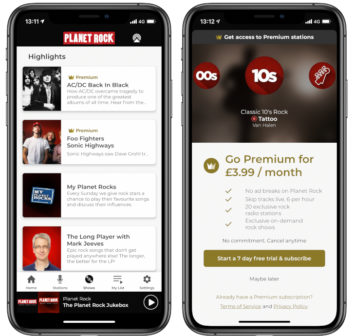
The listener base helped Bauer monetize new options and features, while expanded analytics told them who, and when, users were consuming content — down to what tracks people were tuning into … and out of.
Revenue Opportunities and Control
This all opens up revenue opportunities. Subscription radio for an enhanced experience is one example, as is targeted audio advertising.
Ultimately, great content underpins it all. Good infrastructure and tools mean that content produced for the live broadcast stations can be easily repurposed for the app, then for a smart speaker or connected car platforms. You go into a system and do it once — and the content gets published across the range of platforms that matter to radio stations.
And because good app infrastructure gives the broadcasters complete control, and enables tight access management, their high-value content and unique intellectual property are protected from hijacking aggregators.
Ultimately, apps are a conduit to increased monetization, analytics, efficiency, content and interactivity. And that’s something that makes everyone happy, from listeners to broadcasters and technology providers.
Comment on this or any story. Email mailto:[email protected] with “Letter to the Editor” in the subject field.






